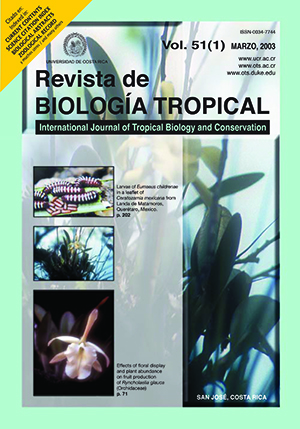Resumen
Se estudió la demografía y ecología de anidación de dos poblaciones de Iguana iguana que enfrentan explotación severa y alteración del hábitat, en la Depresión Momposina, Colombia. Los datos de transectos lineales fueron analizados con el modelo de Fourier para estimar la densidad de grupos sociales. El tamaño promedio de grupo y la densidad general de iguanas varió dentro y entre poblaciones (1.05 - 6.0 grupos/ha, y 1.5 - 13.7 iguanas/ha respectivamente). Las estimaciones de densidad fueron mucho menores que las reportadas en áreas más protegidas en Panamá y Venezuela. Las densidades de las iguanas fueron considerablemente mayores en sitios localizados a lo largo de los ríos (2.5 iguanas/grupo) que en sitios en el margen de las ciénagas (1.5 iguanas/grupo), probablemente debido a diferencias en la vegetación. No hubo correlación entre las estimaciones de densidad y la de abundancia relativa (número de iguanas vistas/hora/persona), debido a diferencias en detectabilidad de los grupos de iguanas entre los sitios. La proporción sexual hallada (1:2.5 machos: hembras), es probablemente el resultado del sistema de apareamiento polígamo de esta especie, en vez de indicar un verdadero sesgo demográfico. Se monitoreó 34 nidos los cuales sufrieron poca depredación por vertebrados. Sin embargo si fueron afectados por inundaciones, pisoteo por ganado e infestación por larvas de mosca Phoridae. El tamaño de huevos por nidada en estas poblaciones fue de 29.4 menor que cualquier otro reporte de la literatura, con la excepción de las poblaciones de Iguana que habitan la isla altamente xérica de Curaçao, implicando que las hembras adultas en nuestra área son inusualmente pequeñas. Probablemente éste es el resultado de la explotación prolongada y excesiva de estas poblaciones en vez de ser una respuesta adaptativa a condiciones ambientales extremas.##plugins.facebook.comentarios##

Esta obra está bajo una licencia internacional Creative Commons Atribución 4.0.
Derechos de autor 2003 Revista de Biología Tropical
Descargas
Los datos de descargas todavía no están disponibles.


